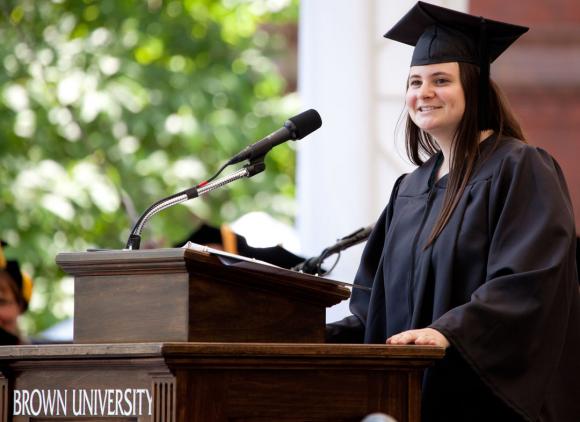Moments ago we walked down the hill to officially mark this momentous occasion. We turned our tassels and then turned again, heading back to our familiar campus for this last moment as Brown students. At the bottom of the hill, we stayed clear of the Providence River, just two blocks away. Now that we are leaving College Hill, we are crossing the river. As graduates, we must navigate new waters as we transition to the next stage of our lives. Therefore it feels appropriate to share a lesson I learned on how to cross a river with confidence.
Last summer, I led a teen trip to Alaska. When we hiked through the snow-capped mountains on the Chilkoot Trail, passing from Alaska into the Yukon Territory, rivers often blocked our path. Luckily, rocks jutted out of the water, spaced just right to step across. I discovered two methods of rock hopping across these rivers. The first, my approach, was to stop and assess. I nervously analyzed the placement of each rock, looking for flat spots where I could place my boot and balance the weight of my pack, and checking for slippery moss surfaces. I would make a plan, hesitate a little, step, repeat. I usually got wet. Then I started watching my more experienced co-counselor, who seemed to cross effortlessly — and dryly — each time. He had no hesitation. Didn’t stop. Wasn’t nervous. Just went for it.
As a Cognitive Science concentrator, I wanted to make sense of the underlying thought process behind these two different rock-hopping methods. When I took a class called “Thinking” (is that meta enough for you, Brown?), I sought a theory to explain the two approaches that I understood as dichotomous, two unique ways of thinking. I came to realize, however, that the hesitation of a novice and the intuitive confidence of an expert are actually two ends of a continuum. My co-counselor’s rock-hopping approach was not void of analysis. Rather, due to his vast hiking experience, his analysis simply took place in the split seconds his foot hovered over each rock. When we all learned to tie our shoes, for example, our actions initially required effort and concentration. Over time and with practice, we became more confident, and tying our shoes became an automatic process. Though I still use the bunny-ears method, I can do it with my eyes closed.
In the 1960s, neuropsychologist Brenda Milner brought attention to a type of implicit memory for skills such as this, known as procedural memory. More recent research has shown that when amnesiacs play Tetris — though they have no explicit memory for playing or practicing — their skills and scores improve significantly over time. Improvements and transitions from one end of the continuum to the other, from inexperience to expertise, from hesitation to confidence, can take place even without our awareness.
The two ends of the continuum are analogous to our growth here at Brown. The first time we all sat together here on the Main Green, President Simmons was speaking, and I was wondering how she could read my mind. She was telling us to silence the doubtful voice inside our heads questioning whether there had been some mistake in our acceptance letters. Still, there were times I doubted my place here. I compared myself to peers researching pandas in China and writing crossword puzzles for the New York Times.
It wasn’t until our senior year that I truly silenced the little questioning voice. I was on my way home from office hours with a professor who had helped me understand a complicated idea about non-causal conditionals. If you're curious, that's what we learn in a "Thinking" class. Suddenly, I paused on the sidewalk with the awesome and simple realization that I had just spent an hour engaging in an intellectual exercise. In addition, I realized I was taking an independent study in a topic I created out of my own interests. I unfroze from my place on the sidewalk, ran home, and exclaimed proudly to my confused roommate, “I’m a Brown Student!” How great is it to be Brown students? We all share these small and large moments of intellectual engagement. They are profound and can be personally significant. They too warrant our pride and celebration.
Our years at Brown have been a time of transformation, of procedural learning. At this institution, we were trained to think and to reason. We have learned to approach ideas critically, just as we would the pattern of a river’s stepping stones. We’ve learned to analyze situations and possible routes across. Though there is no endpoint to the refinement of one’s ability to think and analyze, we’re now expert enough to trust our feet. After four years of practice, we are not even aware when we are engaging in intellectual conversations — thinking critically is what we do.
Over the last four years we’ve practiced crossing many rivers — big and small — and we’ve learned what routes work best for us. No matter which stream we follow, what riverbank we land on, and whether we know our destination or not, Brown has taught us to ask the right questions and propose solutions. We are now able to cross without hesitation, and more, upon our arrival, make better and greener the other side. We will hop from rock to rock trusting the intuitions, skills, and relationships that we have developed. With each stride, we will make an impact befitting our Brunonian character — a character that cares, challenges, and then takes action. Let us cross together, confidently! Class of 2012, congratulations!

